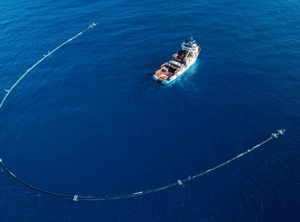MARINE LITTER
Ocean Cleanup project hits a snag / Waste slips out with the fish / Overhaul planned / Team confident problems can be fixed
 Ocean Cleanup founder says problems can be fixed (Photo: The Ocean Cleanup) |
While much of the world has its mind on Christmas dinner and unwrapping presents, engineers working on the Ocean Cleanup (Delft / The Netherlands; www.theoceancleanup.com), a much-publicised project to rid the seas of marine litter, will be putting their heads together to understand why the giant floating contraption conceived by 24-year-old Dutch entrepreneur Boyan Slat doesn’t work as it should. The project team last month acknowledged that although the solar-powered marine vessel swept up plastics and other litter in the “Great Pacific Garbage Patch” as envisaged, the waste slipped back into the ocean again.
In September 2018, the floating armada made of UHMW-PE was towed 1,536 km from San Francisco, California / USA to the patch between California and Hawaii, where some estimates say 1.8 tr pieces of plastic may be floating, to begin its work after five years of planning – see Plasteurope.com of 27.08.2018. But shortly after the hopeful launch, Ocean Cleanup’s engineers became aware that they would have to tweak the construction. In a blog post and numerous interviews, Slat acknowledged that the waste’s escape was clearly defeating the purpose of the project. In early December, the unwieldy device was towed back to California for an overhaul. The organisers have expressed confidence, however, that the problems can be fixed, and the vessel will soon be back in the patch doing the job it was intended to.
In September 2018, the floating armada made of UHMW-PE was towed 1,536 km from San Francisco, California / USA to the patch between California and Hawaii, where some estimates say 1.8 tr pieces of plastic may be floating, to begin its work after five years of planning – see Plasteurope.com of 27.08.2018. But shortly after the hopeful launch, Ocean Cleanup’s engineers became aware that they would have to tweak the construction. In a blog post and numerous interviews, Slat acknowledged that the waste’s escape was clearly defeating the purpose of the project. In early December, the unwieldy device was towed back to California for an overhaul. The organisers have expressed confidence, however, that the problems can be fixed, and the vessel will soon be back in the patch doing the job it was intended to.
Overhaul to increase speed of Ocean Cleanup vessel
The difficulty seems to lie partly in the 600-metre floating plastic array of connected booms that form what looks like a giant horseshoe on the surface of the ocean. To avoid trapping or disturbing marine life – one of the main points of critical assessment of the concept by scientists – the vessel does not use nets, but rather an impermeable “skirt” that hangs three metres below its floating buoys. The idea was that, as water cannot pass through the skirt, the current flows beneath and the fish could easily slip out. The waste, however, should be concentrated in the middle of the barrier, where it could later be scooped up and taken to shore for recycling.
One of the team’s theories as to what went wrong is that while the system was designed to move faster than the plastic, thus allowing the waste to be captured, It may actually at times be moving too slowly to keep its “catch” inside. It is also possible, as Slat wrote on the Ocean Cleanup website, that the vibrations in the ends of the U-shaped device could be creating a type of ripple-force field that repels the plastic as it nears the mouth of the system. Over the next few weeks, the project engineers will work on enabling the floating barrier to catch more wind and waves and increase speed enough to allow it to start capturing plastic again. “What we’re trying to do has never been done before,” Slat told US media. “So, of course we were expecting to still need to fix a few things before it becomes fully operational.”
One of the team’s theories as to what went wrong is that while the system was designed to move faster than the plastic, thus allowing the waste to be captured, It may actually at times be moving too slowly to keep its “catch” inside. It is also possible, as Slat wrote on the Ocean Cleanup website, that the vibrations in the ends of the U-shaped device could be creating a type of ripple-force field that repels the plastic as it nears the mouth of the system. Over the next few weeks, the project engineers will work on enabling the floating barrier to catch more wind and waves and increase speed enough to allow it to start capturing plastic again. “What we’re trying to do has never been done before,” Slat told US media. “So, of course we were expecting to still need to fix a few things before it becomes fully operational.”
21.12.2018 Plasteurope.com [241412-0]
Published on 21.12.2018
